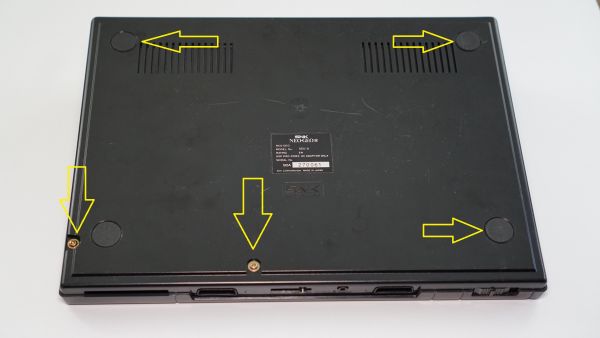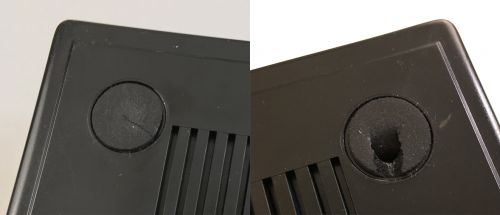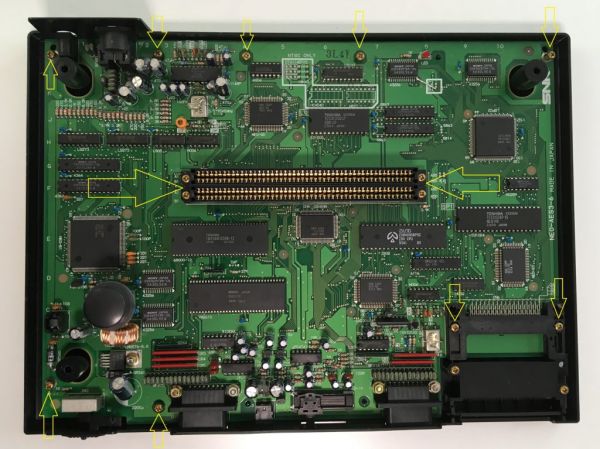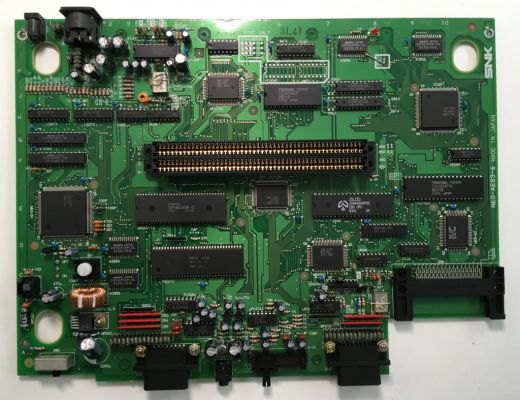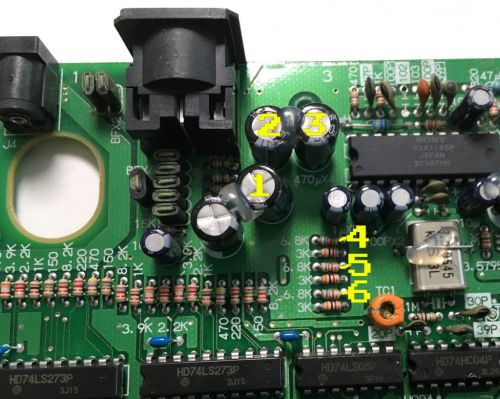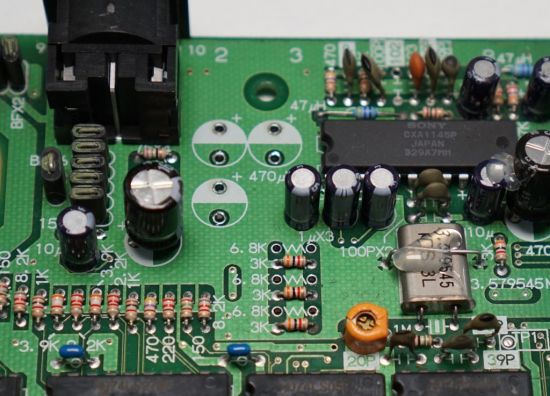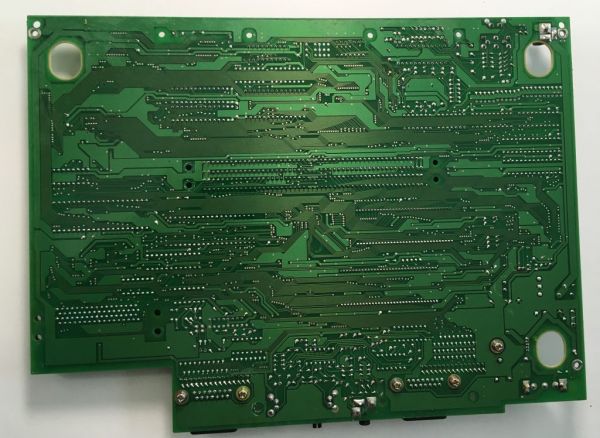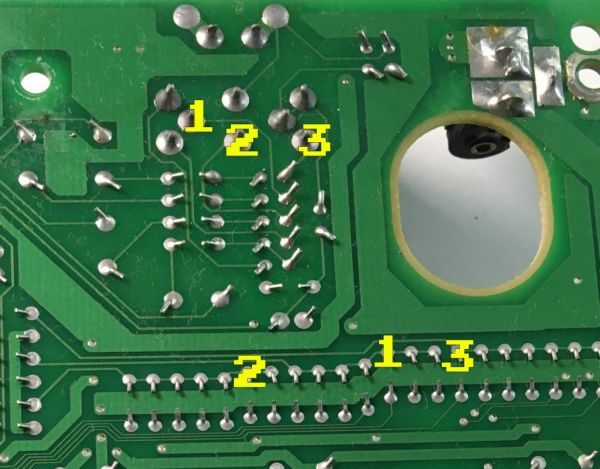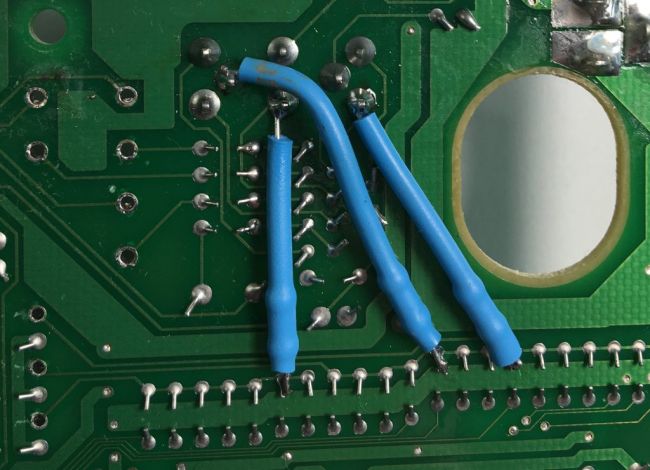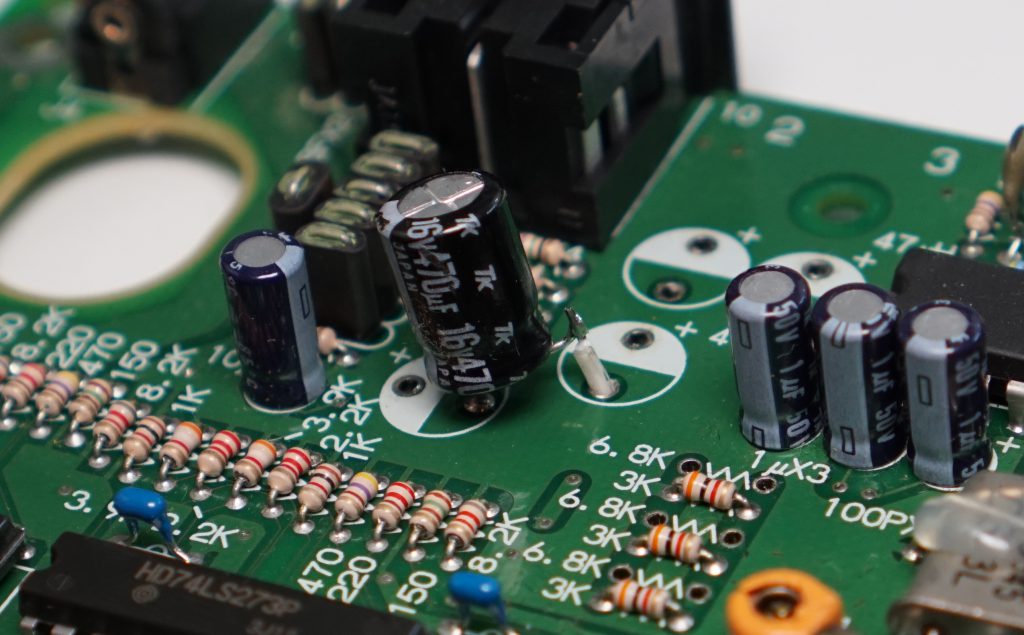Neo Geo:RGB Bypass Mod (AES): Difference between revisions
(Neo Geo wiki now exists) |
(more changes) |
||
| (7 intermediate revisions by 2 users not shown) | |||
| Line 1: | Line 1: | ||
This page will show you a "basic" RGB bypass for the Neo Geo AES console that eliminates the Sony CXA amp and sends RGBS video (at the proper voltages) directly from the NG's digital-to-analog-converter, to the multi-out. The method shown here will work on any Neo Geo revision, but care must be taken when deciding what points to solder to as the traces change between revisions. It's been long discussed that some Neo Geo units output better RGB video than others. While that's true, all AES' can have a fairly simple RGB bypass performed that gets the best out of the built-in DAC. That means you can make every revision AES look identical, regardless of serial number. This modification is also strongly recommended if you plan on feeding RGB output to any RetroTink device. | |||
This page will show you a "basic" bypass for the Neo Geo AES console that eliminates the Sony CXA amp and sends video (at the proper | |||
== Comparisons == | |||
[[File:NeoGeoAES3-6- | * Video comparison: | ||
<youtube>https://www.youtube.com/watch?v=0ysA7U4BYXs</youtube> | |||
* SMPTE color bar comparison (click for full screen): | |||
*: [[File:NeoGeoAES3-6 BaAcolorbars.png|400px]] | |||
* [https://www.retrorgb.com/aes-rgb-bypass.html Oscilloscope analysis (RetroRGB)] | |||
== Installation == | |||
The images in this guide show the process for the 3-6 revision of the Neo Geo. But care must be taken when doing this on other systems. | |||
=== Tools Needed === | |||
* Basic soldering skills | * Basic soldering skills | ||
* Soldering iron, wire, heatshrink tubing | * Soldering iron, wire, heatshrink tubing | ||
* [https://www.digikey.com/product-detail/en/vishay-bc-components/MBB02070C1500FCT00/BC3614CT-ND/7351044 150 Ohm resistors] | * [https://www.digikey.com/product-detail/en/vishay-bc-components/MBB02070C1500FCT00/BC3614CT-ND/7351044 150 Ohm resistors] | ||
* 75 Ohm resistors | |||
* 470uF 16V capacitor | |||
* Desoldering gun not necessary, but might make it easier | * Desoldering gun not necessary, but might make it easier | ||
=== Disassembly === | |||
# Remove the screws on the bottom of the AES. There are three under the marked footpads in the image below. Please note that the screws are different sizes, so make sure to mark where each goes! | |||
#: [[File:NeoGeoAES3-6_Bottom.jpg|600px]] | |||
#* Unfortunately, due to the age of these footpads, they'll most likely break. If you get lucky, you can peel them back just enough to get your screwdriver in, but expect to accidentally break at least one: | |||
#: [[File:NeoGeoAES3-6_Footpads.jpg|500px]] | |||
# After removing the top plastic cover, remove the following screws from the motherboard. | |||
#: [[File:NeoGeoAES3-6_MotherboardScrews-1024x767.jpg|600px]] | |||
# Remove the reset button and power switch, then carefully lift the motherboard out of the bottom case. | |||
=== '''AV Connector output''' === | |||
Originally from Neo Geo [https://wiki.neogeodev.org/index.php?title=Pinouts Dev wiki], provided here for convenience. | |||
(add image of back of Neo Geo with pinout) | |||
This maps to the following on the underside: | |||
(will add image of underside here) | |||
On some systems (Revision 3-6 especially) the composite video output and CSYNC are connected together. Cut this trace: | |||
(will add image of trace being cut here) | |||
=== Neo Geo RGB Amp === | |||
The Neo Geo AES uses the CXA1145 RGB amp. More information about this amp, and more importantly, the pinout can be found [https://wiki.console5.com/wiki/CXA1145 here]. Refer to the pinout when reviewing the rest of the modification below. | |||
=== RGB Bypass === | |||
The traces going between the stock RGB amp (CXA1145) and the AV output port might differ between releases, but the pinout on the amp is the same. The instructions shown here are more focused on 3-5/3-6 PCBs but they can easily be modified to work with older Neo Geo AES PCB revisions once the basic concept is understood. The 2 most confusing parts are where does one pickup the RGB signals for the output and how to handle composite video and CSYNC as in later revisions these 2 output pins are connected together and AES CSYNC output is just composite video. | |||
# Verify that the RGB and composite video capacitors on to the top side of the motherboard are 470uF 16V capacitors. If they are not, replaced them. | |||
# Cut the trace going between the positive pin of the 4 capacitor and the corresponding RGB and composite video pins of the CXA1145 amp (pins 23,22,21 and 20) | |||
# Remove the 3 resistors that sit between the RGB capacitors and multiAV port. On 3-5/3-6 systems, these will be 75 ohm resistors. On older AES PCBs, these will be 68 ohm. If your system uses 68 ohm resistors, remove all 5 of them (3 for RGB, 1 for CSYNC, 1 for composite video) You can easily tell what resistor does what by using a multimeter between one of the resistor legs and the AV port in the back in diode or continuity mode. | |||
# Install 3 150 ohm resistors where the old RGB resistors were which you just removed. If you also removed 68 ohm resistors that used to be composite video and csync, replace them with 75 ohm resistor(s). | |||
# Next is the most confusing part of the RGB mod as it is dependent on what AES revision you have, and every revision is slightly different. You need to connect the RGB signals from the DAC to the positive side of the capacitors from step 1 above. This is where the RGB signals is fed back to the AV output connector, bypassing the CXA1145. Examine the following image. This will demonstrate how one can trace RGB on this PCB and select where to solder the wires. Do the same on your PCB, start at the RGB input pins on the CXA1145 and work backwards until you reach the DAC. Solder wire from the DAC to the positive pin of the 470uF capacitor. Repeat this for all 3 RGB lines. (insert image here of the underside of the CXA1145) | |||
=== CSYNC Restore === | |||
On newer AES PCBs, CSYNC and composite video is connected together and only composite video signal is output on both pins of the AV connector. Now that the signals are separate, it's time to restore the CSYNC signal. The assumption here is that you know what is the CSYNC output pin (see image above) and there's already a 75 ohm resistor connecting to it, and it connects to a 470uF capacitor which currently has it's positive left disconnected. | |||
# Restore the CSYNC signal by connecting a wire from pin 10 of the CXA1145 chip to the positive pin of the CSYNC 470uF capacitor. If you did this correctly, you'll have CXA1145 pin 10 -> wire -> 470uF capacitor -> 75 ohm resistor -> AV port. | |||
=== Composite Video Restore === | |||
On older AES PCBs, there should be 1 more capacitor and resistor left for composite video. Confirm that the capacitor is 470uF and the resistor is 75 ohm. The positive left of this capacitor should be connected to pin 20 of the CXA1145. If you have a newer AES PCB, you must build this circuit to handle composite video. The best spot to do this is right on top of the CXA1145. | |||
# Connect the positive leg of a 470uF 16V capacitor to pin 20 of the CXA1145 | |||
# Connect a 75 ohm resistor to the negative leg of this capacitor | |||
# Run wire from the other side of the 75 ohm resistor to the ferrite bead that connects to the composite video output pin of the AV port | |||
Congrats. You're done. The CXA1145 RGB amp is now bypassed for RGBS but is still used for composite video generation. You can use a Sega Genesis 1 AV cable to test composite video output. | |||
#Now you'll need to remove six components located in the top-left of the motherboard, next to the A/V out port: | == old bypass method shown below - will be removed when section above is completed in the next 24h: == | ||
# Now you'll need to remove six components located in the top-left of the motherboard, next to the A/V out port: three resistors and three capacitors. The ideal way to remove them is with a desoldering gun, however if you're careful, you can use a soldering iron and some tweezers, or even gently snip them out with flush cutters. The area should look like the picture on the right when finished. | |||
# | #: [[File:NeoGeoAES3-6_TopMotherboard-1024x787.jpg|520px]] [[File:NeoGeoAES3-6 RemoveRGBcomponents-1024x817.jpg|500px]] [[File:NeoGeoAES3-6_RemovedRGBcomponents-1024x737.jpg|550px]] | ||
#You'll need to connect each of the following points with a 150Ohm resistor | # Flip the motherboard over and locate the area near the A/V Multi-out in the upper right of this picture: | ||
# | #: [[File:NeoGeoAES3-6_MotherboardBottom-1024x748.jpg|600px]] | ||
# You'll need to connect each of the following points with a 150Ohm resistor, no wire required with the following technique: | |||
## Starting with the #1 resistor in the above picture (as that's the only one that needs a bend in the routing), solder one end of the resistor to one of the lower points. | |||
## Measure and position the resistor with the connection points on the multi-out (top pins) and trim to size. | |||
## Add heatshrink tubing. | |||
## Solder the top connection in place. | |||
## Add some heat to shrink the tubing down for a nice connection. | |||
##: [[File:NeoGeoAES3-6_RGBpointsBefore-1024x801.jpg|600px]] [[File:NeoGeoAES3-6_RGBpointsAfter-1024x740.jpg|650px]] | |||
=== Sync Isolation === | |||
{{Note|This mod may not be needed at all on other revision AES consoles. Technically, this isn't "needed" on the 3-6 units either, but it's strongly recommended to do it. You'll get a cleaner signal at a better voltage.}} | |||
# | # Connect a wire to the bottom of pin 11 (CSYNC-out) of the Sony CXA. Run that wire through one of the existing holes of a capacitor you previously removed. '''DO NOT SOLDER TO THE HOLE''', simply push the wire through to the other side! | ||
#: [[File:NeoGeoAES3-6_CXAsync-1024x596.jpg]] | |||
# | # Carefully snip the positive input leg of the following capacitor and carefully rotate it. If you have a desoldering iron, it would be much better to desolder the whole cap, rotate it and solder the negative side back in place: | ||
#Lastly, solder the wire that you ran through the hole, to the positive input side of the capacitor you just rotated. | #: [[File:NeoGeoAES3-6_CompositeVideoCap-1024x599.jpg]] | ||
# Lastly, solder the wire that you ran through the hole, to the positive input side of the capacitor you just rotated. Then snip any excess. | |||
#: [[File:NeoGeoAES3-6_CompositeVideoCapCsync-1024x635.jpg]] | |||
Latest revision as of 21:35, 7 October 2024
This page will show you a "basic" RGB bypass for the Neo Geo AES console that eliminates the Sony CXA amp and sends RGBS video (at the proper voltages) directly from the NG's digital-to-analog-converter, to the multi-out. The method shown here will work on any Neo Geo revision, but care must be taken when deciding what points to solder to as the traces change between revisions. It's been long discussed that some Neo Geo units output better RGB video than others. While that's true, all AES' can have a fairly simple RGB bypass performed that gets the best out of the built-in DAC. That means you can make every revision AES look identical, regardless of serial number. This modification is also strongly recommended if you plan on feeding RGB output to any RetroTink device.
Comparisons
- Video comparison:
- SMPTE color bar comparison (click for full screen):
- Oscilloscope analysis (RetroRGB)
Installation
The images in this guide show the process for the 3-6 revision of the Neo Geo. But care must be taken when doing this on other systems.
Tools Needed
- Basic soldering skills
- Soldering iron, wire, heatshrink tubing
- 150 Ohm resistors
- 75 Ohm resistors
- 470uF 16V capacitor
- Desoldering gun not necessary, but might make it easier
Disassembly
- Remove the screws on the bottom of the AES. There are three under the marked footpads in the image below. Please note that the screws are different sizes, so make sure to mark where each goes!
- Unfortunately, due to the age of these footpads, they'll most likely break. If you get lucky, you can peel them back just enough to get your screwdriver in, but expect to accidentally break at least one:
- After removing the top plastic cover, remove the following screws from the motherboard.
- Remove the reset button and power switch, then carefully lift the motherboard out of the bottom case.
AV Connector output
Originally from Neo Geo Dev wiki, provided here for convenience.
(add image of back of Neo Geo with pinout)
This maps to the following on the underside:
(will add image of underside here)
On some systems (Revision 3-6 especially) the composite video output and CSYNC are connected together. Cut this trace:
(will add image of trace being cut here)
Neo Geo RGB Amp
The Neo Geo AES uses the CXA1145 RGB amp. More information about this amp, and more importantly, the pinout can be found here. Refer to the pinout when reviewing the rest of the modification below.
RGB Bypass
The traces going between the stock RGB amp (CXA1145) and the AV output port might differ between releases, but the pinout on the amp is the same. The instructions shown here are more focused on 3-5/3-6 PCBs but they can easily be modified to work with older Neo Geo AES PCB revisions once the basic concept is understood. The 2 most confusing parts are where does one pickup the RGB signals for the output and how to handle composite video and CSYNC as in later revisions these 2 output pins are connected together and AES CSYNC output is just composite video.
- Verify that the RGB and composite video capacitors on to the top side of the motherboard are 470uF 16V capacitors. If they are not, replaced them.
- Cut the trace going between the positive pin of the 4 capacitor and the corresponding RGB and composite video pins of the CXA1145 amp (pins 23,22,21 and 20)
- Remove the 3 resistors that sit between the RGB capacitors and multiAV port. On 3-5/3-6 systems, these will be 75 ohm resistors. On older AES PCBs, these will be 68 ohm. If your system uses 68 ohm resistors, remove all 5 of them (3 for RGB, 1 for CSYNC, 1 for composite video) You can easily tell what resistor does what by using a multimeter between one of the resistor legs and the AV port in the back in diode or continuity mode.
- Install 3 150 ohm resistors where the old RGB resistors were which you just removed. If you also removed 68 ohm resistors that used to be composite video and csync, replace them with 75 ohm resistor(s).
- Next is the most confusing part of the RGB mod as it is dependent on what AES revision you have, and every revision is slightly different. You need to connect the RGB signals from the DAC to the positive side of the capacitors from step 1 above. This is where the RGB signals is fed back to the AV output connector, bypassing the CXA1145. Examine the following image. This will demonstrate how one can trace RGB on this PCB and select where to solder the wires. Do the same on your PCB, start at the RGB input pins on the CXA1145 and work backwards until you reach the DAC. Solder wire from the DAC to the positive pin of the 470uF capacitor. Repeat this for all 3 RGB lines. (insert image here of the underside of the CXA1145)
CSYNC Restore
On newer AES PCBs, CSYNC and composite video is connected together and only composite video signal is output on both pins of the AV connector. Now that the signals are separate, it's time to restore the CSYNC signal. The assumption here is that you know what is the CSYNC output pin (see image above) and there's already a 75 ohm resistor connecting to it, and it connects to a 470uF capacitor which currently has it's positive left disconnected.
- Restore the CSYNC signal by connecting a wire from pin 10 of the CXA1145 chip to the positive pin of the CSYNC 470uF capacitor. If you did this correctly, you'll have CXA1145 pin 10 -> wire -> 470uF capacitor -> 75 ohm resistor -> AV port.
Composite Video Restore
On older AES PCBs, there should be 1 more capacitor and resistor left for composite video. Confirm that the capacitor is 470uF and the resistor is 75 ohm. The positive left of this capacitor should be connected to pin 20 of the CXA1145. If you have a newer AES PCB, you must build this circuit to handle composite video. The best spot to do this is right on top of the CXA1145.
- Connect the positive leg of a 470uF 16V capacitor to pin 20 of the CXA1145
- Connect a 75 ohm resistor to the negative leg of this capacitor
- Run wire from the other side of the 75 ohm resistor to the ferrite bead that connects to the composite video output pin of the AV port
Congrats. You're done. The CXA1145 RGB amp is now bypassed for RGBS but is still used for composite video generation. You can use a Sega Genesis 1 AV cable to test composite video output.
old bypass method shown below - will be removed when section above is completed in the next 24h:
- Now you'll need to remove six components located in the top-left of the motherboard, next to the A/V out port: three resistors and three capacitors. The ideal way to remove them is with a desoldering gun, however if you're careful, you can use a soldering iron and some tweezers, or even gently snip them out with flush cutters. The area should look like the picture on the right when finished.
- Flip the motherboard over and locate the area near the A/V Multi-out in the upper right of this picture:
- You'll need to connect each of the following points with a 150Ohm resistor, no wire required with the following technique:
- Starting with the #1 resistor in the above picture (as that's the only one that needs a bend in the routing), solder one end of the resistor to one of the lower points.
- Measure and position the resistor with the connection points on the multi-out (top pins) and trim to size.
- Add heatshrink tubing.
- Solder the top connection in place.
- Add some heat to shrink the tubing down for a nice connection.
Sync Isolation
| This mod may not be needed at all on other revision AES consoles. Technically, this isn't "needed" on the 3-6 units either, but it's strongly recommended to do it. You'll get a cleaner signal at a better voltage. |
- Connect a wire to the bottom of pin 11 (CSYNC-out) of the Sony CXA. Run that wire through one of the existing holes of a capacitor you previously removed. DO NOT SOLDER TO THE HOLE, simply push the wire through to the other side!
- Carefully snip the positive input leg of the following capacitor and carefully rotate it. If you have a desoldering iron, it would be much better to desolder the whole cap, rotate it and solder the negative side back in place:
- Lastly, solder the wire that you ran through the hole, to the positive input side of the capacitor you just rotated. Then snip any excess.

